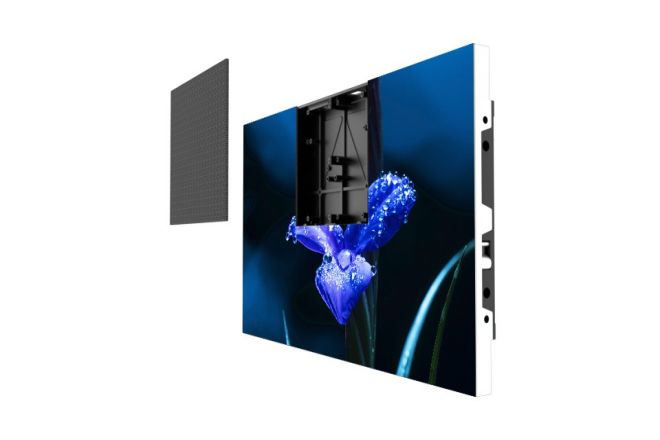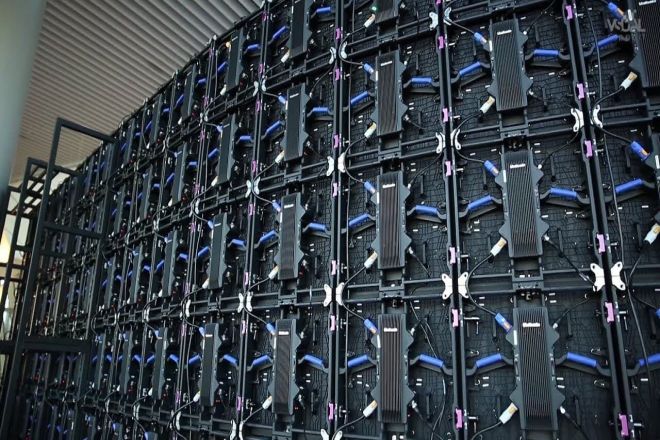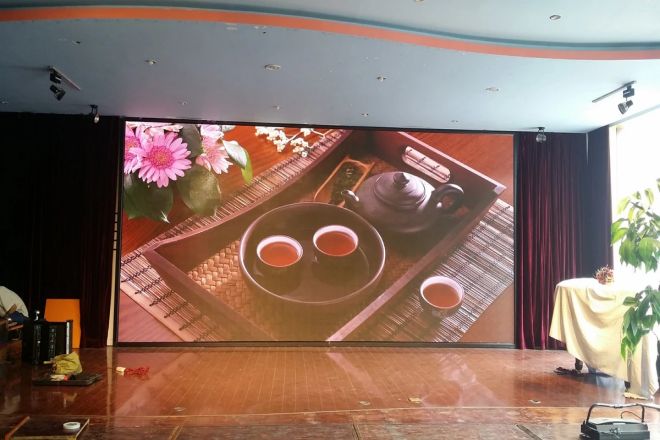Introduction

Avec le progrès continu de la science et de la technologie et l’avènement de l’ère numérique, Écrans d'affichage LED ont été largement utilisés dans divers domaines et sont devenus un outil indispensable pour l'affichage d'informations, la publicité, l'affichage de conférences, les performances de divertissement et d'autres activités.
Sa haute luminosité, sa haute définition, son grand angle de vision et sa longue durée de vie rendent l'écran LED de plus en plus important sur le marché.
Cependant, dans l'application de grands écrans LED, en particulier lorsque plusieurs écrans doivent être assemblés pour former une zone d'affichage plus grande, la méthode d'assemblage traditionnelle présente souvent des écarts d'assemblage évidents, ce qui affecte non seulement la cohérence et l'esthétique de l'effet visuel, mais peut également avoir un impact négatif sur la transmission et l'effet d'affichage des informations.
Par conséquent, l’émergence de la technologie d’épissure sans couture a apporté des changements révolutionnaires à l’application des écrans LED.
1. Principe de la technologie d'épissure sans couture des écrans LED
1). Épissure physique et épissure logique
L'épissure physique consiste à connecter plusieurs écrans LED directement à l'aide d'un support ou d'un cadre. Cependant, il peut y avoir des écarts évidents de cette manière, ce qui affectera l'effet de visualisation. L'épissure logique consiste à utiliser des moyens techniques pour faire en sorte que plusieurs écrans forment visuellement un tout sans écart.
2). Le cœur de la technologie d'épissure sans couture
La technologie d'épissure sans couture est principalement utilisée pour intégrer visuellement plusieurs écrans LED de manière parfaite. Elle comprend les points clés suivants :
Alignement au niveau des pixels : laissez les pixels de plusieurs écrans s'aligner parfaitement pour donner l'impression d'un grand écran.
Correction des couleurs : ajustez la couleur de chaque écran afin qu'ils soient identiques et qu'il n'y ait aucune différence de couleur.
Uniformité de la luminosité : assurez-vous que la luminosité de chaque écran est cohérente, afin qu'il n'y ait pas de luminosité inégale après l'épissage.
3). Étapes à suivre pour obtenir un épissage sans couture
Pour obtenir une technologie d’épissure transparente, vous devez suivre les étapes suivantes :
- Sélection et calibrage de l'écran :
Tout d'abord, vous devez sélectionner l'écran LED approprié en fonction de vos besoins réels et l'étalonner. Le processus d'étalonnage comprend la vérification de la qualité des pixels, de la précision des couleurs, de l'uniformité de la luminosité et d'autres indicateurs de l'écran pour garantir que chaque écran répond aux exigences d'un raccordement homogène.
- Conception et disposition des coutures :
Concevez le schéma d'épissure en fonction des besoins réels et déterminez la position, l'angle et le mode de connexion de chaque écran. Dans le même temps, il est également nécessaire de prendre en compte la transmission et la distribution des signaux pour garantir que le signal peut être transmis avec précision et stabilité à chaque écran.
- Installation et débogage :
Installez-le conformément au schéma de conception et de disposition de l'épissure pour garantir que chaque écran peut être fixé de manière stable et ferme dans la position désignée. Une fois l'installation terminée, déboguez-la, vérifiez si l'effet d'affichage de chaque écran est cohérent et affinez-le si nécessaire jusqu'à ce que le meilleur effet soit obtenu. Enfin, l'ensemble du système est testé et vérifié pour s'assurer qu'il peut fonctionner normalement et répondre aux besoins réels.
2. Technologies clés de la technologie d'épissure sans soudure des écrans LED

1). Technologie d'étalonnage au niveau des pixels
La technologie d'étalonnage au niveau des pixels est l'un des éléments clés de la technologie d'épissure transparente des écrans LED. Elle garantit que les pixels entre les écrans adjacents peuvent être alignés avec précision pendant le processus d'épissure pour former un écran d'affichage continu et sans fracture.
- Réglage de la précision des pixels :
En ajustant avec précision les pixels de chaque écran LED pour garantir que les pixels de l'écran adjacent peuvent correspondre avec précision lors de l'épissage afin d'éliminer la sensation de fracture causée par un mauvais alignement des pixels.
- Correction de la dislocation des pixels :
Lors du processus d'épissure, un mauvais alignement des pixels peut se produire pour diverses raisons (erreurs d'installation, déformation de l'écran, etc.). La technologie de mauvais alignement des pixels peut détecter et corriger ces dislocations pour réaligner les pixels.
2). Technologie de gestion des couleurs
La technologie de gestion des couleurs est essentielle pour garantir la cohérence des couleurs de l'affichage LED après un épissure sans couture.
- Correspondance de l'espace colorimétrique :
Il peut y avoir des différences d'espace colorimétrique entre les différents écrans LED. La technologie de correspondance de l'espace colorimétrique peut garantir que les couleurs affichées sur différents écrans peuvent être présentées avec précision dans le même espace colorimétrique après l'épissage.
- Optimisation de la cohérence des couleurs :
Grâce à un équipement et à un logiciel de correction des couleurs professionnels, la couleur de chaque écran LED est calibrée et optimisée afin qu'elle puisse présenter un effet de couleur cohérent et précis après l'épissage.
3). Technologie de contrôle de la luminosité et du contraste
La technologie de contrôle de la luminosité et du contraste joue un rôle important dans l’amélioration de l’effet visuel global de l’écran LED après un épissage sans couture.
- Technologie d'égalisation de la luminosité :
En raison des différences possibles dans la luminosité des différents écrans LED, la technologie d'égalisation de la luminosité peut ajuster automatiquement la luminosité de chaque écran pour afficher un effet de luminosité uniforme après l'épissage.
- Algorithme d’amélioration du contraste :
Le contraste est l'un des facteurs importants qui affectent l'effet d'affichage. L'algorithme d'amélioration du contraste peut améliorer le contraste de l'image et rendre l'image plus claire et plus vive en traitant l'image. Dans l'épissage sans couture de l'affichage LED, l'algorithme d'amélioration du contraste peut encore améliorer l'effet visuel global après l'épissage.
3. Scénarios d'application de la technologie d'épissure sans soudure des écrans LED
- Domaine de la publicité commerciale
La technologie d'épissure sans couture des écrans LED a une large gamme d'applications dans le domaine de la publicité commerciale. Les grands centres commerciaux et les panneaux d'affichage extérieurs utilisent souvent des écrans LED sans couture pour attirer l'attention des clients et améliorer l'image de marque. La technologie d'épissure sans couture permet à plusieurs écrans LED de former visuellement un tout, présentant un effet publicitaire plus choquant et plus cohérent.
- Représentation sur scène et présentation lors d'une conférence
Lors de représentations sur scène ou de conférences, l'affichage LED parfaitement assemblé peut offrir des méthodes d'affichage plus flexibles et plus diversifiées. Par exemple, l'écran d'arrière-plan du concert peut afficher des effets visuels réalistes grâce à une technologie d'assemblage sans couture, renforçant ainsi le sentiment d'immersion du public.
Lors de la conférence internationale, l'écran LED parfaitement assemblé peut afficher des graphiques, des données et des vidéos complexes, offrant aux participants un contenu d'affichage clair et intuitif.
- Domaine de la surveillance et de la sécurité
Dans des endroits tels que les centres de surveillance de la sécurité publique et les centres de commande de la circulation, les écrans LED sans couture jouent un rôle important. Grâce à la technologie d'épissure sans couture, plusieurs écrans de surveillance peuvent être intégrés sur un grand écran pour réaliser une surveillance en temps réel et une planification des commandes.
Cette application améliore non seulement l’efficacité de la surveillance, mais aide également les services concernés à détecter et à répondre aux urgences en temps opportun.
- Autres scénarios d'application
Outre les domaines mentionnés ci-dessus, il existe de nombreux autres scénarios d'application pour les écrans LED à épissure transparente. Par exemple, dans la simulation virtuelle et la formation par simulation, l'écran LED à épissure transparente peut simuler des scènes et des environnements réalistes pour améliorer l'effet de formation.
Dans les expériences de réalité virtuelle (VR) et de réalité augmentée (AR), la technologie d'épissage transparent peut fournir un effet d'expérience plus immersif, afin que les utilisateurs puissent obtenir une expérience plus réaliste.
4. Défis et tendances de développement de la technologie d'épissure sans soudure des écrans LED

1). Défis techniques existants
Bien que la technologie d’épissure sans couture des écrans LED ait fait des progrès remarquables, elle est encore confrontée à certains défis techniques.
- Amélioration de la résolution et de la densité de pixels :
Avec les progrès continus de la technologie d'affichage, les exigences des utilisateurs en matière de résolution et de densité de pixels augmentent également. Comment améliorer encore la résolution et la densité de pixels tout en garantissant un effet de collage homogène est un problème technique qui doit être résolu à l'heure actuelle.
- Réduction supplémentaire des écarts d'épissure :
Bien que la technologie d'épissure transparente existante ait pu obtenir des écarts d'épissure plus petits, dans certains scénarios où l'effet d'affichage est extrêmement exigeant, il est toujours nécessaire de réduire davantage les écarts d'épissure pour offrir une expérience visuelle parfaite.
- Contrôle des coûts et amélioration de l'efficacité :
Avec la large application de la technologie d'épissure sans couture d'affichage LED, la réduction des coûts de production et l'amélioration de l'efficacité de la production sont également des problèmes à résoudre dans le développement technologique.
2). Tendances futures du développement
- Technologie d'épissure intelligente et automatisée :
Avec le développement de l'intelligence artificielle et de la technologie d'automatisation, la future technologie d'épissure sans couture des écrans LED sera plus intelligente et automatisée. Grâce à l'introduction d'algorithmes intelligents et d'équipements d'automatisation, un processus d'épissure plus précis et plus efficace peut être réalisé, et l'efficacité de la production et la qualité du produit peuvent être améliorées.
- Raccordement sans couture d'un écran LED flexible :
L'écran LED flexible est fin et flexible, ce qui lui permet de s'adapter à des besoins d'affichage plus complexes. La future technologie d'épissure sans couture sera appliquée aux écrans LED flexibles pour obtenir un effet d'affichage plus flexible et plus évolutif.
- Exploration et application de nouveaux matériaux d'affichage :
Avec l'émergence continue de nouveaux matériaux d'affichage, la future technologie d'épissure transparente des écrans LED utilisera davantage de nouveaux matériaux pour offrir de meilleurs effets et performances d'affichage. Par exemple, la technologie d'affichage à points quantiques peut offrir une gamme de couleurs plus large et une luminosité plus élevée, offrant ainsi davantage de possibilités à la technologie d'épissure transparente.
Conclusion
Après une discussion approfondie sur la technologie d'épissage sans couture des écrans LED, nous pouvons clairement voir le rôle important joué par cette technologie dans la promotion du progrès technologique et l'expansion des applications de l'industrie de l'affichage LED.
Enfin, si vous souhaitez en savoir plus sur les écrans LED, veuillez nous contacter.
